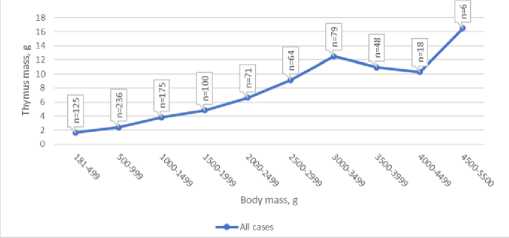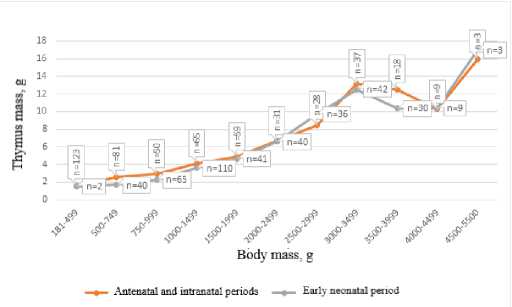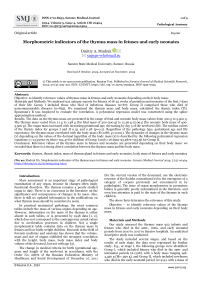Morphometric indicators of the thymus mass in fetuses and early neonates
Автор: Dmitry A. Mudrak
Журнал: Saratov Medical Journal @sarmj
Статья в выпуске: 4 Vol.5, 2024 года.
Бесплатный доступ
Objective: to identify reference values of thymus mass in fetuses and early neonates depending on their body mass. Materials and Methods. We analyzed 922 autopsy reports for fetuses of 18-42 weeks of gestation and neonates of the first 7 days of their life: Group I included those who died of infectious diseases (n=67); Group II comprised those who died of noncommunicable diseases (n=855). We examined the thymus mass and body mass, calculated the thymic index (TI). Spearman’s R was employed to evaluate the correlation. A polynomial regression model was constructed using the spline approximation method. Results. The data on the thymus mass are presented in the range of fetal and neonate body mass values from 300 g to 5,500 g. The thymus mass varied from 1.1 g to 1.48 g (for fetal mass of 300-500 g) to 12.36 g-15.09 g (for neonate body mass of 400-5,500 g). The organ mass increased with increasing gestational age, decreasing by day 3 of the newborn’s life. The median values of the thymic index for groups I and II 0.32 and 0.28 (p=0.2). Regardless of the pathology type, gestational age and life expectancy, the thymus mass correlated with the body mass (R=0.88; p<0.001). The dynamics of changes in the thymus mass (y) depending on the values of the decimal logarithm of the body mass (x) is described by the following polynomial regression equations: y=13.937x2-75.662x+104.47 for children of Group I and y=16.65x2-93.487x+133.56 for Group II. Conclusion. Reference values of the thymus mass in fetuses and neonates are presented depending on their body mass: we revealed that there is a strong direct correlation between the thymus mass and the body mass.
Thymus, thymic index, mass of thymus gland in fetuses and early neonates, body mass of fetuses and early neonates
Короткий адрес: https://sciup.org/149148544
IDR: 149148544 | DOI: 10.15275/sarmj.2024.0404
Текст научной статьи Morphometric indicators of the thymus mass in fetuses and early neonates
© This article is an open access publication. Russian Text. Published in Saratov Journal of Medical Scientific Research, 2024; 20 (4): 505-510. EDN: XUJMTT. https://doi. org/io.i5275/ssmj5O5. ISSN 1995-0039.
Mass assessment is an important stage of pathological examination of any organ, because its changes often imply functional disorders. The thymus remains a poorly studied organ to date. There is no consensus in the literature on the significance and consequences of changes in its mass. Also, there is still no updated information in the publications on what thymus mass should be considered a norm.
In practical anatomical pathology, the most common tables include the mass of various organs depending on age. However, information on the mass of the thymus is either absent in such tables, or is presented by 1948 data [1, 2], which does not correspond to the contemporary actual values due to acceleration processes in children. Not a single morphometric table contains data on the thymus mass in fetuses and low-birth-weight children. Research in the field of forensic medicine and anatomy has shown that the volume, mass and size of organs exhibited the strongest correlation with the height, body mass, body mass index and body volume of the deceased, but not with age [3].
The change in medical criteria for birth (gestational age, mass and length of the newborn) in accordance with the Order No. 1687n of the Russian Federation Ministry of Healthcare and Social Development of December 27, 2011
(for the current version of the document, use the electronic resource of the Kodeks consortium) led to the emergence of a category of corpses previously not encountered in by pathologists. The issue of organ morphometry in premature babies is generally poorly systematized in the literature, and even less attention is paid to the state of the thymus in such children.
The above facts determine the relevance of this study.
Objective – to identify reference values of the thymus mass in fetuses and early neonates depending on their body mass.
Materials and Methods
Our study assessed the thymus mass 922 infants and fetuses who died in the ante-, intra- and early neonatal periods from 2010 to 2017 in Saratov hospitals. An analytical descriptive study was conducted.
The study included several stages, and based on the results of each stage, the data were regrouped for further study. E.g., at stage I, the following groups were identified: Group I, which included fetuses who died in the ante- and intranatal periods (n=508), with a body mass ranging 1484,450 g (Me: 950 g), and Group II, which included newborns who died in the early neonatal period (n=414), with a mass of
440-6,200 g (Me: 1,480 g). At this stage, we established that the most common causes of fetal death were congenital disorders, intrauterine asphyxia, and (less often) intrauterine infection. In newborns, the causes of death were pneumopathy, intraventricular hemorrhage, malformations, and infectious pathology.
At stage II of the study, all cases were divided into two groups: Group I included fetuses and newborns who died from infectious diseases (n=67) and Group II comprised fetuses and newborns who died from noncommunicable diseases (n=855). Then, in these groups, based on the TI (%) values, two subgroups were identified. Subgroup A included 249 cases (23 with infectious pathology and 226 with noncommunicable pathology) with TI values in the range of up to the 25th percentile (first quartile). Subgroup B comprised 451 cases (29 with infectious pathology and 422 with noncommunicable pathology). Subgroup С encompassed 222 cases (15with infectious pathology and 207 with noncommunicable pathology) with TI values in the range above the 75th percentile (upper quartile).
The following parameters were examined in the course of our study: thymus mass, body mass, and TI. The latter was calculated as the ratio of the thymus mass to the child’s body mass, expressed as a percentage.
Statistical data processing was performed using the Microsoft Excel software. Preliminary calculation of the sample size was not performed. Normality of distribution was calculated using the Kolmogorov-Smirnov method. Since the distribution of mass values in the groups did not correspond to the normal distribution, the following parameters were calculated: median, 25th and 75th percentiles, minimum and maximum. The Mann–Whitney U test was employed to assess the statistical significance of differences, and the Spearman’s nonparametric R-test was performed to identify the strength of correlation. A polynomial regression model using the spline approximation method (piecewise polynomial regression) was used to describe the change in thymus mass depending on body mass. The study assessed 6 groups (2 groups with 3 subgroups in each); therefore, taking into account the Bonferroni correction, the differences were considered statistically significant at p<0.008 (p=0.05/6).
Results
When investigating the dynamics of changes in the thymus mass in fetuses that died in the ante- and intranatal periods, we discovered that the thymus mass initially increased steadily with an increase of a gestation age, while in the last week of pregnancy it decreased slightly. In the early neonatal period, a decrease in the thymus mass can be noted by the day 3 of the newborn’s life, which, apparently, is a reflection of adaptation processes ( Figure 1 ).
Similar dynamics of changes in the thymus mass was observed depending on the body mass of fetuses and neonates: an increase in the thymus mass occurred gradually until the body mass reached 3,500 g ( Figure 2 ).
A comparative analysis demonstrated that the dynamics of changes in the thymus mass of fetuses and newborns occurred in the same direction ( Figure 3 ).
At the next stage of our study, all cases were divided into two groups: Group I with fetuses and newborns who died from infectious diseases (n=67) and Group II with fetuses and newborns who died from noncommunicable diseases (n=855).
This classification is due to the fact that the thymus is the main organ of immunogenesis in the age range under study and the human immune system experiences the highest stress during the development of infectious diseases.
The body mass of children in the study Group II was twice as much as the body mass of children in the Group I. Similar trend was noted for the thymus mass ( Table 1 ): i.e., the dynamics of both body mass and thymus mass were unidirectional, regardless of the pathology type.
Based on the collected data, we decided to analyze the behavior of such an integral indicator as TI, which is often used in pediatric practice and by ultrasound diagnosticians.
The median values of TI were 0.32 and 0.28 for Groups I and II, respectively (p=0.2).

Figure 1. Dynamics of changes in the thymus mass in fetuses and newborns who died in the antenatal, intranatal, and early neonatal periods (by gestational age and life expectancy)

Figure 2. Dynamics of the thymus mass in fetuses and newborns depending on their body mass

Figure 3. Dynamics of thymus mass depending on body mass in the group of fetuses and in the group of neonates
Table 1. Body mass and thymus values in those who died from infectious and noncommunicable diseases, g
|
Group |
Mass, Ме [ Q 25 - Q 75 ], (min-max) |
р |
|
|
Body |
Thymus |
||
|
I (infectious diseases) |
1,230 [716 2,370], (200 7,800) |
3 [2-6], (1 49) |
<0.001 |
|
II (noncommunicable diseases) |
2,700 [1,621 3,530], (630 9,786) |
7 [4-11], (1 56) |
|
Calculation of the Spearman correlation coefficient (R) yielded a strong direct correlation between body mass and thymus mass (R=0.88; p<0.001).
At the next stage of our study, we carried out an analysis of the TI graph in two groups of children who died from infectious and noncommunicable diseases. Each group included fetuses of different gestation ages, as well as newborns with different life expectancies.
Analysis of the TI curves in the range of the 1st quartile in those who died from infectious and noncommunicable pathologies showed that the unidirectional dynamics of changes in the thymus mass and body mass was observed only up to 4,000 g of body weight. For this group, the polynomial regression was described by the following equations: y=1.837x2–6.1775x+3.8531 for the subgroup with infectious pathology and y=6.3614x2–33.732x+45.539 for the subgroup with noncommunicable pathology, and the regression graph lines intersected at two points.
When analyzing the TI curves in the range of the upper quartile in those who died from infectious and noncommunicable pathologies, unidirectional dynamics of changes in the thymus mass and body mass were noted too. The following regression equations were calculated for this group: y=83.683x2–520.97x+816.83 for the subgroup with noncommunicable pathology and y=20.118x2– 104.04x+136.46 for the subgroup with infectious pathology, and the regression graph lines also intersected at two points.
Such patterns of the regression implied that some external factors influenced the dynamics of changes in thymus mass with an increase in body mass in these groups.
Analysis of the TI curves in the range from the 25th to the 75th percentiles in those who died from infectious and noncommunicable pathologies showed that the lines of the polynomial regression curves overlapped in nearly the entire examined range. The shapes of the regression curves were described by the following equations: y=13.937x2– 75.662x+104.47 for the subgroup with noncommunicable diseases and y=16.65x2–93.487x+133.56 for the subgroup with infectious diseases ( Figure 4 ). These data allowed us to conclude that this trend excludes the effect of other factors, in particular the nature of the disease, the gestational age of fetuses, and life expectancy in newborns.
That is why the data on the thymus mass and body mass of fetuses and newborns in this group formed the basis for compiling a table with morphometric indicators ( Table 2 ).
Table 2. Reference values of thymus mass depending on body mass in study subjects
|
Morphom etric indicator |
Reference values |
||||||
|
ад и СП Л 2 |
body |
. |
500599 |
600699 |
700799 |
800899 |
900999 |
|
thym us |
1.1 1.48 |
1.85 2.09 |
1.88 2.08 |
2.08 2.18 |
2-2.13 |
2,96 3,13 |
|
|
body |
1000 - 1099 |
11001199 |
12001299 |
13001399 |
14001499 |
15001999 |
|
|
thym us |
2.97 3.11 |
3-3.13 |
3.96 4.11 |
4.76 4.96 |
4.44 4.58 |
4,63 5,39 |
|
|
body |
2000 - 2499 |
25002999 |
30003499 |
35003999 |
4000-5500 |
||
|
thym us |
6.38 7.11 |
9.51 10.22 |
10.23 11.17 |
12.54 13.12 |
12.36-15.09 |
||
Discussion
Indisputably, knowledge of the normal thymus mass is essential for routine pediatric practice. The thymus is a key organ of the immune system, responsible throughout life for the tolerance, immune response, and production of immunocompetent T cells. In addition, the concept of the thymus role has now expanded, as we consider it an organ of integration of the immune and endocrine systems [4].
The pathologist, playing a major role in establishing the mechanisms and forensic aspects of death and making a final diagnosis in cases of death, must have reliable thymus mass reference values at hand, since the morphofunctional state of this organ significantly affects the development of any disease and its outcome, especially in childhood.
The tables by A.I. Abrikosov (1948) [1], which are referred to in later editions by other authors [2, 5], provide data on the thymus mass at different age periods. Even though these data are of great practical importance in the work of pathologists dealing with autopsies of adult corpses, accumulated experience suggested that in infancy the strongest correlation is observed between the thymus mass and the child’s body mass.
The table of thymus mass data in fetuses and newborns weighing from 300 g to 5,500 g that we compiled has confirmed the dependence of the thymus mass in this age period on the fetus or neonate mass. Similar trends have been previously described by some other authors [6, 7]. E.g., L.V. Kulida indicated the presence of a strong direct correlation between the thymus mass and body mass in full-term neonates and a moderate direct relationship in children with extremely low body mass [6].
There is published evidence that in the presence of infectious diseases with the normal development of the thymus, its mass exceeds the thymus mass in noncommunicable diseases. These changes are explained by the formation of transient thymomegaly [8, 9].
In our study, we observed this tendency solely in children with a body mass of more than 4,000 g in the study group with TI values in the range above the 75th percentile.
The direct strong correlation between the thymus mass and the mass of the fetus or newborn that we established in this study is consistent with the results of other authors [7, 10]. At present, the trend to determine the norm not by age/gestation age, but rather by relation to body mass is gaining more and more popularity. For instance, a number of authors noted that the correlation of some organ mass is stronger in relation to body mass than to age [11-13].
In clinical practice, the thymus mass is calculated by various methods [14-17]. Pediatricians and ultrasound diagnosticians are guided by the TI value calculated as the percentage of the thymus mass to the child’s body mass. These values are not entirely correct to use for comparison with the data obtained during autopsy, since there are indications in the literature that the actual thymus mass exceeds the mass calculated via ultrasound examination by 1.6 times [18].
We should point out that among the literature available to us, there were only a few publications on the thymus morphology of low-birth-weight and premature neonates with extremely low body weight [19, 20]. In these articles, the authors noted a decrease in the TI values but specific values of thymus mass were not presented. This circumstance determines the value of the thymus mass table proposed by us for pediatric pathologists.
Conclusion
As a result of the conducted study, we revealed a direct strong correlation between body mass and thymus mass. Based on the data analysis, we came up with a table of thymus mass distribution depending on body mass, which is of great importance in the practical work of a pathologist.
Informed consent for publication: The authors obtained written consent from the patients’ legal representatives for the analysis and publication of medical data.
Author contributions: All authors contributed equally to the preparation of the manuscript.
Conflict of interest: None declared by the authors.
(00)00401-1
Russ.)


